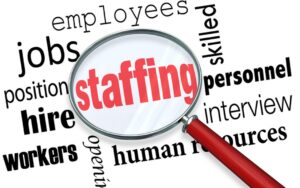The purpose of this article is to summarize our experience working with staffing agencies and why we determined that something needed to change. We understand the important role that staffing agencies play in both senior living and skilled nursing. That being said, truly believed there had to be a better way.
Since COVID, the reliance on staffing agencies in the senior living and skilled nursing sectors has been a growing concern for facility operators. While agency usage is gradually decreasing in senior living and skilled nursing in some markets, it remains prevalent and will continue to have a lasting impact on both sectors. According to the American Health Care Association Survey of 441 Nursing Home Providers, March 2024, 73% of nursing homes still rely on agency staff. This highlights the ongoing impact of agency staffing on labor costs and operations.
The Inefficiencies of Managing Multiple Staffing Agencies
After reviewing internal processes and interviewing schedulers at various facilities, we discovered a significant operational bottleneck: most facilities maintain contracts with five or six staffing agencies but actively use only one or two. This inefficiency is primarily due to the complexity of scheduling with multiple agencies.
Schedulers often face the exhausting task of juggling multiple communication methods—emailing some agencies, calling others, and manually entering open shifts into agency-specific platforms. This fragmented process consumes valuable time and creates significant inefficiencies, making it increasingly difficult for schedulers to manage their workload effectively. Additionally, they must track these platforms to confirm if shifts are being filled and cancel them in the portals if they already confirmed an assignment with another agency, further complicating their workload. As a result, facilities default to working with the agencies that make it easiest for their team to fill the shifts, even if they are the most expensive options.
Lack of Transparency and Overspending
A major operational pain point is the lack of accurate tracking when using agency labor. With multiple team members contacting agencies to cover last-minute callouts, agency staffing becomes the “easy button.” This decentralized process leads to poor record-keeping on how much agency labor is used, resulting in inefficient reporting and significant overspending.
The Costly Consequences of Dependency
Beyond poor reporting, inefficiencies often force facilities to rely on just one or two agencies to fill all shifts. This lack of competition leads to higher costs, as facilities may feel pressured to accept inflated rates, including overtime pay for agency staff. Paying overtime for external agency staff is unnecessary and preventable with a more efficient system that fosters competition among agencies. How much would your facility save if you could eliminate 90-100% of your agency overtime spending?
The Solution: Building a Smarter System to Fill Open Shifts
Recognizing these challenges, we set out to develop a solution that would streamline the process of filling open shifts for facility operators. After thoroughly documenting existing workflows and analyzing best practices, we concluded that facilities should not be the ones adapting to agency-specific systems—instead, agencies should be adapting to facility needs.
This insight led to the development of Bloomtrak, a platform that is “built for operators, by operators.” Our goal with Bloomtrak was to shift the power back to facility schedulers by allowing them to enter open shifts into a centralized platform rather than relying on multiple means of communication, including entering shifts into individual agency platforms. Using Bloomtrak, agencies, and internal team members are notified of open shifts, and agencies can view all open shifts in one place, fostering a competitive and transparent staffing process.
The Results: Lower Costs, Better Visibility, and Smarter Decision-Making
Facilities using Bloomtrak have seen almost a 20% reduction in the average rate of agency-filled shifts, leading to significant cost savings. Additionally, facilities have seen roughly a 10% increase in the number of shifts that were filled by facility employees after already being assigned to an agency, which drives additional savings and helps improve continuity of care for residents and patients. Additionally, facility and regional leadership now have real-time visibility into agency labor usage, preventing untracked spending.
Furthermore, Bloomtrak’s reporting capabilities provide actionable insights, allowing facilities to identify which positions and shifts are being filled by agencies and to implement strategic incentives, such as shift differentials or rate adjustments, to attract more in-house team members and further reduce agency reliance.
Conclusion
The inefficiencies of working with staffing agencies have long plagued the senior living and skilled nursing sectors, leading to unnecessary costs and operational headaches. By creating a streamlined, centralized solution to fill open shifts, Bloomtrak has simplified the process of working with agencies while also introducing market forces and competition. This shift empowers facilities to reduce costs, increase transparency, and make data-driven staffing decisions—ultimately leading to more sustainable labor practices in healthcare.
As these industries continue to navigate staffing challenges, solutions like Bloomtrak demonstrate that innovation and efficiency can drive real, measurable improvements in senior living and skilled nursing operations.
By Shareef Tahboub
Bloomtrak Co-Founder



